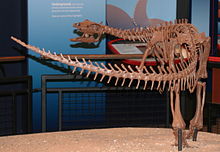
Dromaeosaurus is a genus of dromaeosaurid theropod dinosaur that lived during the Late Cretaceous period, sometime between 80 and 69 million years ago, in Alberta, Canada and the western United States. The type species is Dromaeosaurus albertensis, which was described by William Diller Matthew and Barnum Brown in 1922. Its fossils were unearthed in the Dinosaur Park Formation. Teeth attributed to this genus have been found in the Prince Creek Formation. Dromaeosaurus is the type genus of both Dromaeosauridae and Dromaeosaurinae, which include many genera with similar characteristics to Dromaeosaurus such as possibly its closest relative Dakotaraptor. Dromaeosaurus was heavily built, more so than other dromaeosaurs that are similar in size, like Velociraptor.

Ankylosaurus is a genus of armored dinosaur. Its fossils have been found in geological formations dating to the very end of the Cretaceous Period, about 68–66 million years ago, in western North America, making it among the last of the non-avian dinosaurs. It was named by Barnum Brown in 1908; it is monotypic, containing only A. magniventris. The generic name means "fused" or "bent lizard", and the specific name means "great belly". A handful of specimens have been excavated to date, but a complete skeleton has not been discovered. Though other members of Ankylosauria are represented by more extensive fossil material, Ankylosaurus is often considered the archetypal member of its group, despite having some unusual features.

Pachycephalosauria is a clade of ornithischian dinosaurs. Along with Ceratopsia, it makes up the clade Marginocephalia. With the exception of two species, most pachycephalosaurs lived during the Late Cretaceous Period, dating between about 85.8 and 66 million years ago. They are exclusive to the Northern Hemisphere, all of them being found in North America and Asia. They were all bipedal, herbivorous/omnivorous animals with thick skulls. Skulls can be domed, flat, or wedge-shaped depending on the species, and are all heavily ossified. The domes were often surrounded by nodes and/or spikes. Partial skeletons have been found of several pachycephalosaur species, but to date no complete skeletons have been discovered. Often isolated skull fragments are the only bones that are found.

Pachycephalosaurus is a genus of pachycephalosaurid ornithischian dinosaur. The type species, P. wyomingensis, is the only known species, but some researchers argue that the genus Stygimoloch might be a second species, P. spinifer or a juvenile specimen of P. wyomingensis. It lived during the Maastrichtian age of the Late Cretaceous period in what is now western North America. Remains have been excavated in Montana, South Dakota, Wyoming, and Alberta. The species is known mainly from a single skull, plus a few extremely thick skull roofs. More complete fossils would come to be found in the following years.

Styracosaurus is an extinct genus of herbivorous ceratopsian dinosaur from the Late Cretaceous of North America. It had four to six long parietal spikes extending from its neck frill, a smaller jugal horn on each of its cheeks, and a single horn protruding from its nose, which may have been up to 60 centimeters long and 15 centimeters wide. The function or functions of the horns and frills have been debated for many years.

Stegoceras is a genus of pachycephalosaurid (dome-headed) dinosaur that lived in what is now North America during the Late Cretaceous period, about 77.5 to 74 million years ago (mya). The first specimens from Alberta, Canada, were described in 1902, and the type species Stegoceras validum was based on these remains. The generic name means "horn roof", and the specific name means "strong". Several other species have been placed in the genus over the years, but these have since been moved to other genera or deemed junior synonyms. Currently only S. validum and S. novomexicanum, named in 2011 from fossils found in New Mexico, remain. The validity of the latter species has also been debated.
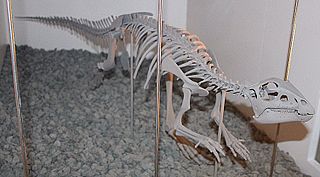
Hypsilophodontidae is a traditionally used family of ornithopod dinosaurs, generally considered invalid today. It historically included many small bodied bipedal neornithischian taxa from around the world, and spanning from the Middle Jurassic until the Late Cretaceous. This inclusive status was supported by some phylogenetic analyses from the 1990s and mid 2000s, although there have also been many finding that the family is an unnatural grouping which should only include the type genus, Hypsilophodon, with the other genera being within clades like Thescelosauridae and Elasmaria. A 2014 analysis by Norman recovered a grouping of Hypsilophodon, Rhabdodontidae and Tenontosaurus, which he referred to as Hypsilophodontia. All other analyses from around the same time have instead found these latter taxa to be within Iguanodontia.
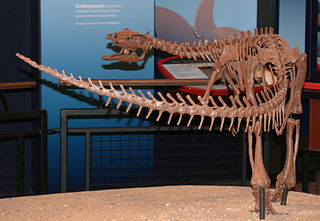
Thescelosaurus was a genus of neornithischian dinosaur that appeared at the very end of the Late Cretaceous period in North America. It was a member of the last dinosaurian fauna before the Cretaceous–Paleogene extinction event around 66 million years ago. The preservation and completeness of many of its specimens indicate that it may have preferred to live near streams.

Prosaurolophus is a genus of hadrosaurid dinosaur from the Late Cretaceous of North America. It is known from the remains of at least 25 individuals belonging to two species, including skulls and skeletons, but it remains obscure. Its fossils have been found in the late Campanian-age Upper Cretaceous Dinosaur Park Formation in Alberta, and the roughly contemporaneous Two Medicine Formation in Montana, dating to around 75.5-74.0 million years ago. Its most recognizable feature is a small solid crest formed by the nasal bones, sticking up in front of the eyes.
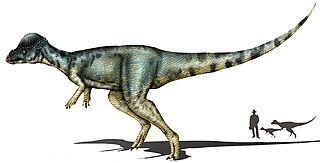
Alaskacephale is an extinct genus of pachycephalosaurid, a group of dome-headed, herbivorous ornithischian dinosaurs, that lived during the Campanian stage of the Late Cretaceous period in what is now northern Alaska. The genus is one of the few known Arctic dinosaurs and was found in the Prince Creek Formation, which preserves a menagerie of fossils. The only known specimen, a squamosal bone, was found in 1999 and later described in 2005. However, Alaskacephale was not formally named until the next year.

Compsognathidae is a family of coelurosaurian theropod dinosaurs. Compsognathids were small carnivores, generally conservative in form, hailing from the Jurassic and Cretaceous Periods. The bird-like features of these species, along with other dinosaurs such as Archaeopteryx inspired the idea for the connection between dinosaur reptiles and modern-day avian species. Compsognathid fossils preserve diverse integument — skin impressions are known from four genera commonly placed in the group, Compsognathus, Sinosauropteryx, Sinocalliopteryx, and Juravenator. While the latter three show evidence of a covering of some of the earliest primitive feathers over much of the body, Juravenator and Compsognathus also show evidence of scales on the tail or hind legs. "Ubirajara jubatus", informally described in 2020, had elaborate integumentary structures on its back and shoulders superficially similar to the display feathers of a standardwing bird-of-paradise, and unlike any other non-avian dinosaur currently described.

Tyrannosaurinae is one of the two extinct subfamilies of Tyrannosauridae, a family of coelurosaurian theropods that consists of at least three tribes and several genera. All fossils of these genera have been found in the Late Cretaceous deposits of western North America and east Asia. Compared to the related subfamily Albertosaurinae, tyrannosaurines overall are more robust and larger though the alioramins were gracile by comparison. This subfamily also includes the oldest known tyrannosaurid genus Lythronax as well as the youngest and most famous member of the group, Tyrannosaurus rex. There were at least 30 different species of tyrannosaurines.

Ornithocheiridae is a group of pterosaurs within the suborder Pterodactyloidea. These pterosaurs were among the last to possess teeth. Members that belong to this group lived from the Early to Late Cretaceous periods, around 140 to 90 million years ago.

Thescelosauridae is a clade of neornithischians from the Cretaceous of Asia, North America and possibly South America. The group was originally used as a name by Charles M. Sternberg in 1937, but was not formally defined until 2013, where it was used by Brown and colleagues as the group uniting Thescelosaurus and Orodromeus, based on their phylogenetic results. During a phylogenetic revision of neornithischians by Clint Boyd in 2015, the authorship of Thescelosauridae was given to Brown and colleagues, which meant that the similar name Parksosauridae, informally defined in 2002 by Buchholz, would have had priority over Thescelosauridae. The two clades had slightly different definitions, with Parksosauridae referring to all animals closer to Parksosaurus than Hypsilophodon, but they contained the same taxa so Boyd used Parksosauridae under the assumption it had priority. However, in formalizing the clade following the regulations of the PhyloCode, Madzia, Boyd, and colleagues identified in 2021 that Sternberg was the proper authority for Thescelosauridae, giving it priority over Parksosauridae. As well, they gave Thescelosauridae the definition of the largest clade containing Thescelosaurus neglectus but not Iguanodon bernissartensis, as long as Hypsilophodon foxii was not in the group, modifying previous definitions for Thescelosauridae in order to maintain its modern use, so that the clade was not applied if Thescelosaurus fell within Hypsilophodontidae, a family that has not been recently used but may be revived if the systematic position of Hypsilophodon was solidified at some point in the future. Madzia et al. identified the analysis of Madzia et al. in 2018 as the reference analysis for the name Thescelosauridae, an analysis based on a revised version of the 2015 Boyd analysis.

Kosmoceratops is a genus of ceratopsid dinosaur that lived in North America about 76–75.9 million years ago during the Late Cretaceous period. Specimens were discovered in Utah in the Kaiparowits Formation of the Grand Staircase–Escalante National Monument in 2006 and 2007, including an adult skull and postcranial skeleton and partial subadults. In 2010, the adult was made the holotype of the new genus and species Kosmoceratops richardsoni; the generic name means "ornate horned face", and the specific name honors Scott Richardson, who found the specimens. The find was part of a spate of ceratopsian discoveries in the early 21st century, and Kosmoceratops was considered significant due to its elaborate skull ornamentation.
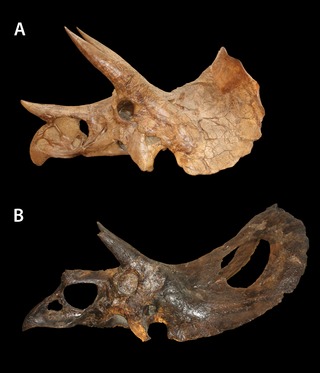
Triceratopsini is a tribe of herbivorous chasmosaurine dinosaurs that lived between the late Campanian to the late Maastrichtian stages of the Cretaceous period, between 74.73 and 66 million years ago. Fossils of these animals have been found in western North America, in particular West Canada, Western and Midwestern United States, which was once part of the ancient continent of Laramidia. The tribe was named by Nicholas R. Longrich in 2011 for the description of Titanoceratops, which he defined as "all species closer to Triceratops horridus than to Anchiceratops ornatus or Arrhinoceratops brachyops". Triceratopsins were the largest of the chasmosaurines; suggesting that gigantism had evolved in the Ceratopsidae once. In addition there is an evolutionary trend in the solidification of the frills, the most extreme being in Triceratops.

Haya is an extinct genus of basal neornithischian dinosaur known from Mongolia.

Orodrominae is a subfamily of thescelosaurid dinosaurs known from the Cretaceous of North America and Asia.

Dineobellator is a genus of dromaeosaurid theropod dinosaur that lived in North America during the Late Cretaceous period 68 million years ago. The remains have been found in the Maastrichtian stage of the Naashoibito Member at the Ojo Alamo Formation, New Mexico.
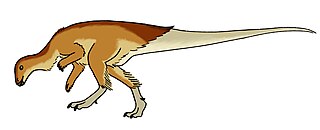
Nevadadromeus is an extinct genus of small thescelosaurine ornithischian dinosaur, from the Willow Tank Formation of Nevada, United States. The genus contains a single species, N. schmitti, which represents the first non-avian dinosaur named from Nevada.
